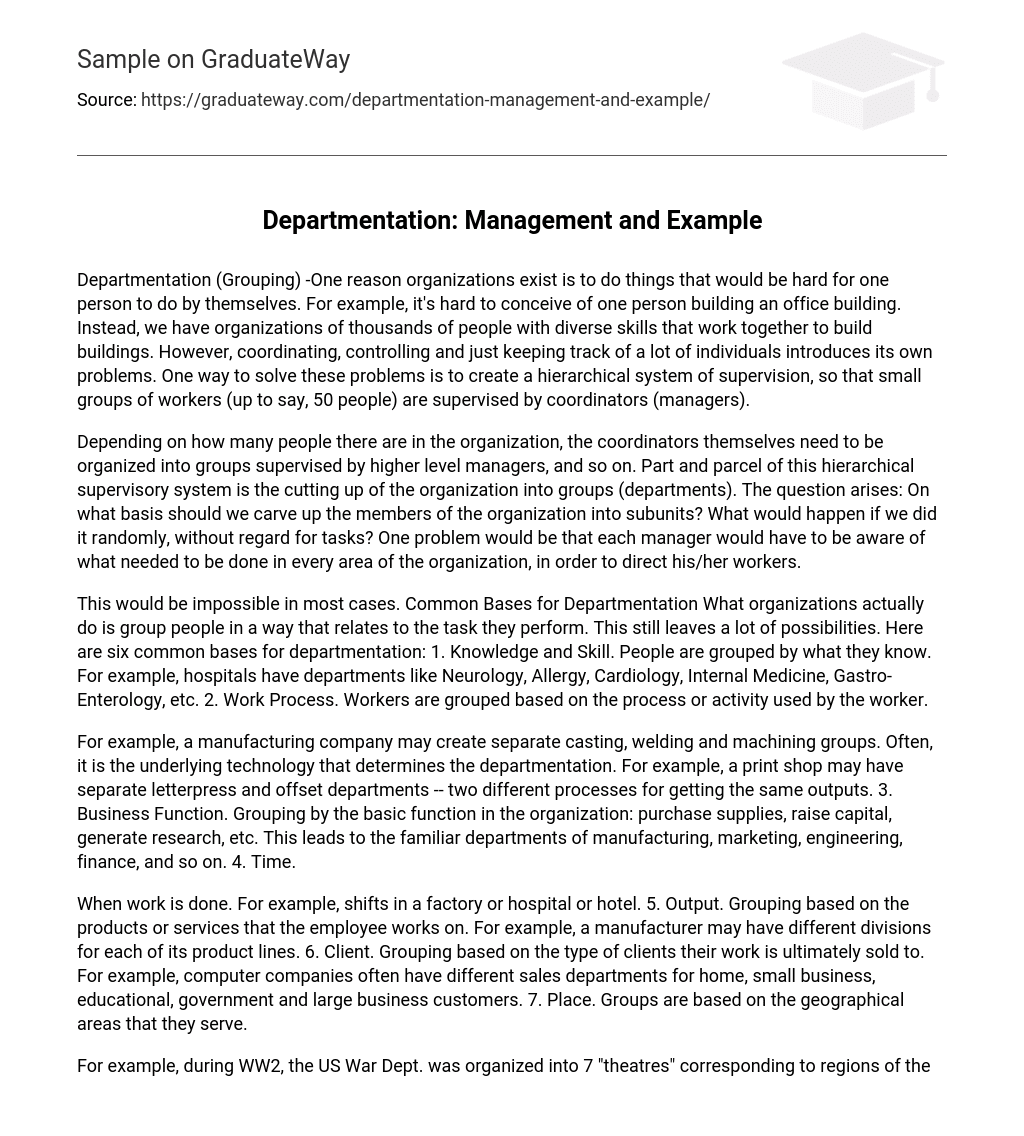Departmentation (Grouping) -One reason organizations exist is to do things that would be hard for one person to do by themselves. For example, it’s hard to conceive of one person building an office building. Instead, we have organizations of thousands of people with diverse skills that work together to build buildings. However, coordinating, controlling and just keeping track of a lot of individuals introduces its own problems. One way to solve these problems is to create a hierarchical system of supervision, so that small groups of workers (up to say, 50 people) are supervised by coordinators (managers).
Depending on how many people there are in the organization, the coordinators themselves need to be organized into groups supervised by higher level managers, and so on. Part and parcel of this hierarchical supervisory system is the cutting up of the organization into groups (departments). The question arises: On what basis should we carve up the members of the organization into subunits? What would happen if we did it randomly, without regard for tasks? One problem would be that each manager would have to be aware of what needed to be done in every area of the organization, in order to direct his/her workers.
This would be impossible in most cases. Common Bases for Departmentation What organizations actually do is group people in a way that relates to the task they perform. This still leaves a lot of possibilities. Here are six common bases for departmentation: 1. Knowledge and Skill. People are grouped by what they know. For example, hospitals have departments like Neurology, Allergy, Cardiology, Internal Medicine, Gastro-Enterology, etc. 2. Work Process. Workers are grouped based on the process or activity used by the worker.
For example, a manufacturing company may create separate casting, welding and machining groups. Often, it is the underlying technology that determines the departmentation. For example, a print shop may have separate letterpress and offset departments — two different processes for getting the same outputs. 3. Business Function. Grouping by the basic function in the organization: purchase supplies, raise capital, generate research, etc. This leads to the familiar departments of manufacturing, marketing, engineering, finance, and so on. 4. Time.
When work is done. For example, shifts in a factory or hospital or hotel. 5. Output. Grouping based on the products or services that the employee works on. For example, a manufacturer may have different divisions for each of its product lines. 6. Client. Grouping based on the type of clients their work is ultimately sold to. For example, computer companies often have different sales departments for home, small business, educational, government and large business customers. 7. Place. Groups are based on the geographical areas that they serve.
For example, during WW2, the US War Dept. was organized into 7 “theatres” corresponding to regions of the world where the US was fighting. Similarly, Post Offices are often divided by regions and zip codes. By function: A collection of collections and a specialization of organization type. Each instance of type of department by function is a collection of Departments (q. v. ) whose instances are distinguished by the fact that they perform a certain function for an organization (e. g. budget department and shipping and receiving department).
Employees with similar jobs (functions) are grouped together. e. g. production, financing, marketing and human resources. Advantages: • Employees can specialise and become experts in certain areas. • Simplifies tasks – each employee works with only one task or skill so it is easier to hire people. • Can be very cost efficient. By product: The purpose of product departmentation is that every product is handled by separate management team and the problems faced in the development of a product are carried out by single group of employees working in that unit.
The disadvantage is that the product managers need to coordinate with each other for the resource sharing which becomes a difficult process because of lesser communication between the product divisions. Sometimes, products of the same company start competing which results in snatching one division profit from other division leaving behind net profit for the company zero. However this kind of structure works best in the big organizations which have lots of products in their product portfolio.





